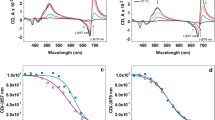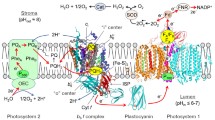Abstract
Thylakoids isolated from peas (Pisum sativum cv. Kelvedon Wonder) and phosphorylated by incubation with ATP have been compared with non-phosphorylated thylakoids in their sensitivity to photoinhibition by exposure to illumination in vitro. Assays of the kinetics of fluorescence induction at 20° C and the fluorescence emission spectra at-196° C indicate a proportionally larger decrease in fluorescence as a result of photoinhibitory treatment of non-phosphorylated compared with phosphorylated thylakoids. It is concluded that protein phosphorylation can afford partial protection to thylakoids exposed to photoinhibitory conditions.
Similar content being viewed by others
Abbreviations
- DCMU:
-
3-(3,4-dichlorophenyl)-1,1-dimethylurea
- F 0 :
-
Level of chlorophyll fluorescence when photosystem 2 traps are open
- F m :
-
Level of chlorphyll fluorescence when photosystem 2 traps are closed
- P:
-
Maximum level of fluorescence reached in the absence of DCMU
- PSI (II):
-
photosystem I(II)
References
Allen, J.F., Bennett, J., Steinback, K.E., Arntzen, C.J. (1981) Chloroplast protein phosphorylation couples plastoquinone redox state to distribution of excitation transfer between photosystems. Nature 291, 1–5
Anderson, J.M. (1982) The significance of grana stacking in chlorophyll b-containing chloroplasts. FEBS Lett. 124, 1–10
Barber, J. (1983) Membrane conformational changes due to phosphorylation and the control of energy transfer in photosynthesis. Photobiochem. Photobiophys. 5, 181–190
Bennett, J. (1980) Chloroplast phosphoproteins. Evidence for a thylakoid-bound phosphoprotein phosphatase. Eur. J. Biochem. 104, 85–89
Bennett, J. (1983) Regulation of photosynthesis by reversible phosphorylation of the light-harvesting a/b protein. Biochem. J. 212, 1–13
Bennett, J., Steinback, K.E., Arntzen, C.J. (1980) Chloroplast phosphoproteins: regulation of excitation energy transfer by phosphorylation of thylakoid membranes. Proc. Natl. Acad. Sci. USA 77, 5253–5257
Bjorkman, O., Holmgren, P. (1963) Adaptability of the photosynthetic apparatus to light intensity in ecotypes from exposed and shaded habitats. Physiol. Plant. 16, 889–894
Critchley, C. (1981) Studies on the mechanism of photoinhibition in higher plants. 1. Effects of high light intensity on chloroplast activities in cucumber adapted to low light. Plant Physiol. 67, 1161–1165
Critchley, C., Smillie, R.M. (1981) Leaf chlorophyll fluorescence as an indicator of photoinhibition in Cucumis sativus L. Aust. J. Plant Physiol. 8, 133–141
Fernyhough, P., Foyer, C.H., Horton, P. (1984) Increase in level of thylakoid protein phosphorylation in maize mesophyll chlorplasts by decrease in the transthylakoid proton gradient. FEBS Lett. 176, 351–353
Fork, D.C., Oquist, G., Powles, S.B. (1981) Photoinhibition in bean: A fluorescence analysis. Carnegie Inst. Washington Yearb. 80, 52–57
Horton, P. (1983a) Control of chloroplast electron transfer by phosphorylation of thylakoid proteins. FEBS Lett. 152, 47–52
Horton, P. (1983b) Relationships between electron transfer and carbon assimilation; simultaneous measurement of chlorophyll fluorescence transthylakoid pH gradient and O2 evolution in isolated chloroplasts. Proc. R. Soc. London Ser. B. 217, 405–416
Horton, P. (1984) Interactions between electron transfer and carbon assimilation. In: Photosynthetic mechanisms and the environment, Barber, J., Baker, N.R., eds. Elsevier Biomedical Press, Amsterdam, in press
Horton, P., Allen, J.F., Black, M.T., Bennett, J. (1981) Regulation of phosphorylation of chloroplast membrane polypeptides by the redox state of plastoquinone. FEBS Lett. 125, 193–196
Horton, P., Black, M.T. (1980) Activation of adenosine 5′triphosphate induced fluorescence quenching by reduced plastoquinone. The basis of state 1 to state 2 transitions in chloroplasts. FEBS Lett. 119, 141–144
Horton, P., Black, M.T. (1981) Light dependent quenching of chlorophyll fluorescence in pea chloroplasts induced by adenosine 5′-triphosphate. Biochim. Biophys. Acta 635, 53–62
Horton, P., Foyer, C.H. (1982) Relationships between protein phosphorylation and electron transport in the reconstituted chloroplast system. Biochem. J. 210, 517–521
Horton, P., Lee, P. (1983) Stimulation of a cyclic electron transfer pathway around photosystem 2 by phosphorylation of chloroplast thylakoid proteins. FEBS Lett. 162, 81–84
Horton, P., Lee, P. (1984) Phosphorylation of chloroplast thylakoids decreases the maximum capacity of photosystem 2 electron transfer. Biochim. Biophys. Acta. 767, 563–567
Jursinic, P.A., Kyle, D.J. (1983) Changes in the redox state of the secondary acceptor of photosystem II associated with light-induced thylakoid protein phosphorylation. Biochim. Biophys. Acta. 723, 37–44
Kyle, D.J., Ohad, I., Guy, R., Arntzen, C.J. (1984) Selective thylakoid protein damage and repair during photoinhibition. In: Advances in photosynthesis research, vol. 3, pp. 67–70, C. Sybesma, ed. Nijhoff/Junk Publishers, The Hague
Lavorel, J., Etienne, A.-L. (1977) In vivo chlorophyll fluorescence. In: Primary process of photosynthesis, pp. 203–268, J. Barber, ed. Elsevier/North Holland Biomedical Press, Amsterdam
Malkin, S., Jones, L.W. (1968) Photoinhibition and excitation quenching in photosystem 2 of photosynthesis from fluorescence induction measurements. Biochim. Biophys. Acta 162, 297–299
Melis, A. (1984) Light regulation of photosynthetic membrane structure, organisation and function. J. Cell. Biochem. 24, 271–285
Ogren, E., Oquist, G. (1984) Photoinhibition of photosynthesis in Lemna gibba as induced by the interaction between light and temperature. III. Chlorophyll fluorescence at 77 K. Physiol. Plant. 62, 193–200
Osmond, B. (1981) Photorespiration and photoinhibition. Some implications for the energetics of photosynthesis. Biochim. Biophys. Acta 639, 77–98
Powles, S.B. (1984) Photoinhibition of photosynthesis induced by visible light. Annu. Rev. Plant Physiol. 35, 15–44
Powles, S.B., Bjorkman, O. (1982) Photoinhibition of photosynthesis: effect on chlorophyll fluorescence at 77 K in intact leaves and in chloroplast membranes of Nerium oleander. Planta 156, 97–107
Powles, S.B., Critchley, C. (1980) Effect of light intensity during growth on photoinhibition of intact attached bean leaflets. Plant Physiol. 65, 1181–1187
Powles, S.B., Osmond, C.B., Thorne, S.W. (1979) Photoinhibition of intact attached leaves of C3 plants illuminated in the absence of both carbon dioxide and of photorespiration. Plant Physiol. 64, 982–988
Powles, S.B., Thorne, S.W. (1981) Effect of high-light treatment in inducing photoinhibition of photosynthesis in intact leaves of low-light grown Phaseolus vulgaris and Lastreopsis microsora. Planta 152, 471–477
Renger, G., Koike, H., Yuasa, M., Inoue, Y. (1983) Studies on the mechanism of the fluorescence decline induced by strong actinic light in PSII particles under different redox conditions. FEBS Lett. 163, 89–93
Ridley, S.M. (1977) Interaction of chloroplasts with inhibitiors. Induction of chlorosis by diuron during prolonged illumination in vitro. Plant Physiol. 59, 724–732
Ridley, S.M., Horton, P. (1984) DCMU-induced photodestruction of pigments associated with an inhibition of photosystem I cyclic electron flow: a working hypothesis. Z. Naturforsch. Teil C 39, 351–353
Shocat, S., Owens, G.C., Hubert, P., Ohad, I. (1982) The dichlorophenyldimethylurea-binding site in thylakoids of Chlamydomonas reinhardi. Role of photosystem II reaction center and phosphorylation of the 32–35 kilodalton polypeptide in the formation of the high affinity binding site. Biochim. Biophys. Acta 681, 21–31
Author information
Authors and Affiliations
Rights and permissions
About this article
Cite this article
Horton, P., Lee, P. Phosphorylation of chloroplast membrane proteins partially protects against photoinhibition. Planta 165, 37–42 (1985). https://doi.org/10.1007/BF00392209
Received:
Accepted:
Issue Date:
DOI: https://doi.org/10.1007/BF00392209




